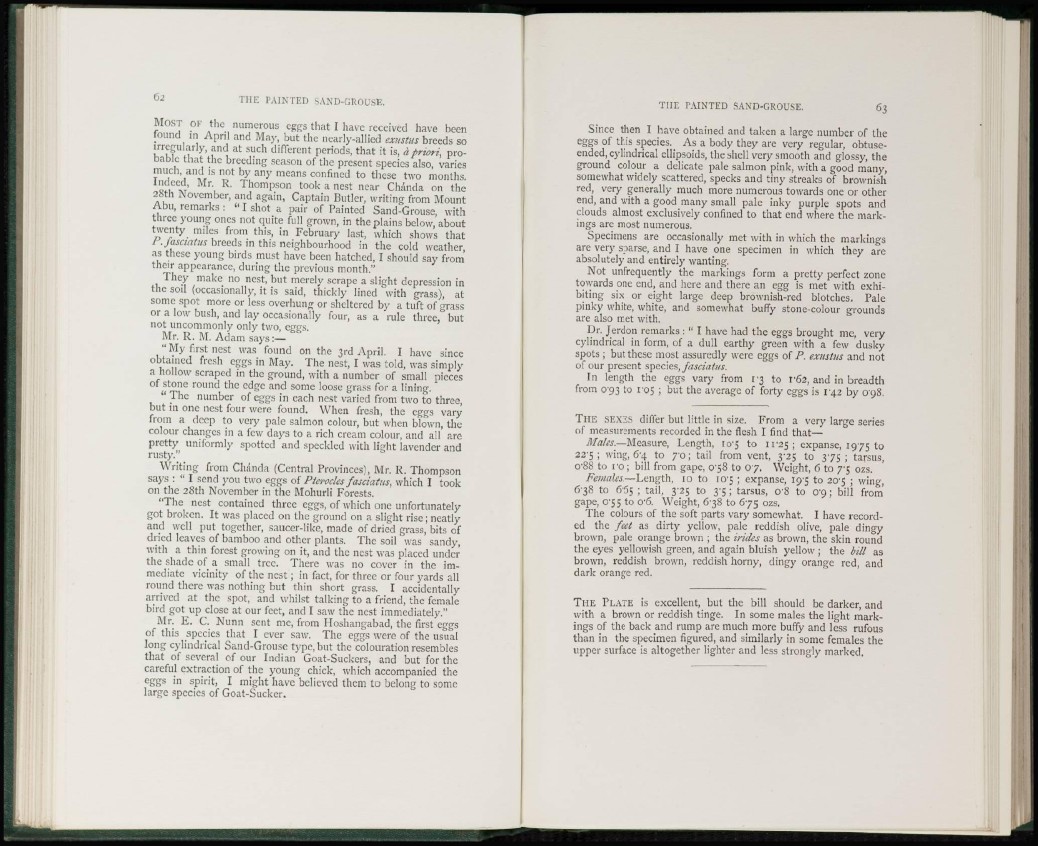
PAINTED SAND-GROUSE.
MOST OF the numerous eggs that I have received have been
found in April and May, but the nearly-allied exustus breeds so
irregularly, and at such different periods, that it is, a priori, probable
that the breeding season of the present species also, varies
much, and is not by any means confined to these two months.
Indeed, Mr. R. Thompson took a nest near ChAnda on the
28th November, and again, Captain Butler, writing from Mount
Abu, remarks : " I shot a pair of Painted Sand-Grouse, with
three young ones not quite full grown, in the plains below, about
twenty miles from this, in February last, which shows that
P. fasciatus breeds in this neighbourhood in the cold weather,
as these young birds must have been hatched, I should say from
their appearance, during the previous month."
They make no nest, but merely scrape a slight depression in
the soil (occasionally, it is said, thickly lined with grass), at
some spot more or less overhung or sheltered by a tuft of grass
or a low bush, and lay occasionally four, as a rule three, but
not uncommonly only two, eggs.
Mr. R. M. Adam says:—
" My first nest was found on the 3rd April. I have since
obtained fresh eggs in May. The nest, I was told, was simply
a hollow scraped in the ground, with a number of small pieces
of stone round the edge and some loose grass for a lining.
" The number of eggs in each nest varied from two to three,
but in one nest four were found. When fresh, the eggs vary
from a deep to very pale salmon colour, but when blown, the
colour changes in a few days to a rich cream colour, and all are
pretty uniformly spotted and speckled with light lavender and
rusty."
Writing from ChAnda (Central Provinces), Mr. R. Thompson
says : " I send you two eggs of Ptcroclcs fasciatus, which I took
on the 28th November in the Mohurli Forests.
"The nest contained three eggs, of which one unfortunately
got broken. It was placed on the ground on a slight rise; neatly
and well put together, saucer-like, made of dried grass, bits of
dried leaves of bamboo and other plants. The soil was sandy,
with a thin forest growing on it, and the nest was placed under
the shade of a small tree. There was no cover in the immediate
vicinity of the nest; in fact, for three or four yards all
round there was nothing but thin short grass. I accidentally
arrived at the spot, and whilst talking to a friend, the female
bird got up close at our feet, and I saw the nest immediately."
Mr. E. C. Nunn sent mc, from Iloshangabad, the first eggs
of this species that I ever saw. The eggs were of the usual
long cylindrical Sand-Grouse type, but the colouration resembles
that of several of our Indian Goat-Suckers, and but for the
careful extraction of the young chick, which accompanied the
eggs in spirit, I might have believed them to belong to some
large species of Goat-Sucker.
TOE PAINTED SAND-GROUSE. 63
Since then I have obtained and taken a large number of the
eggs of this species. As a body they are very regular, obtuseended,
cylindrical ellipsoids, the shell very smooth and glossy, the
ground colour a delicate pale salmon pink, with a good many,
somewhat widely scattered, specks and tiny streaks of brownish
red, very generally much more numerous towards one or other
end, and with a good many small pale inky purple spots and
clouds almost exclusively confined to that end where the markings
arc most numerous.
Specimens are occasionally met with in which the markings
are very sparse, and I have one specimen in which they are
absolutely and entirely wanting.
Not unfrequently the markings form a pretty perfect zone
towards one end, and here and there an egg is met with exhibiting
six or eight large deep brownish-red blotches. Pale
pinky white, white, and somewhat buffy stone-colour grounds
are also met with.
Dr. Jerdon remarks : " I have had the eggs brought me, very
cylindrical in form, of a dull earthy green with a few dusky
spots ; but these most assuredly were eggs of P. exustus and not
of our present species, fasciatus.
In length the eggs vary from 13 to vGi, and in breadth
from 0'93 to ro5 ; but the average of forty eggs is 142 by 098.
THE SEXES differ but little in size. From a very large series
of measurements recorded in the flesh I find that—
Males.—Measure, Length, io'5 to 11-25 ; expanse, 1975 to
225 ; wing, 6'4 to 70; tail from vent, 3-25 to 375 ; tarsus,
0'88 to ro ; bill from gape, C 5 8 to 07. Weight, 6 to 7-5 ozs.
Females.—Length, 10 to 105 ; expanse, 195 to 20'5 ; wing,
638 to 6-65 ; tail, 3-25 to 3-5; tarsus, 08 to 0'9; bill from
gape, C55 to 0'6. Weight, 6'38 to 675 ozs.
The colours of the soft parts vary somewhat. I have recorded
the feet as dirty yellow, pale reddish olive, pale dingy
brown, pale orange brown ; the irides as brown, the skin round
the eyes yellowish green, and again bluish yellow ; the bill as
brown, reddish brown, reddish horny, dingy orange red, and
dark orange red.
THE PLATE is excellent, but the bill should be darker and
with a brown or reddish tinge. In some males the light markings
of the back and rump are much more buffy and less rufous
than in the specimen figured, and similarly in some females the
upper surface is altogether lighter and less strongly marked.